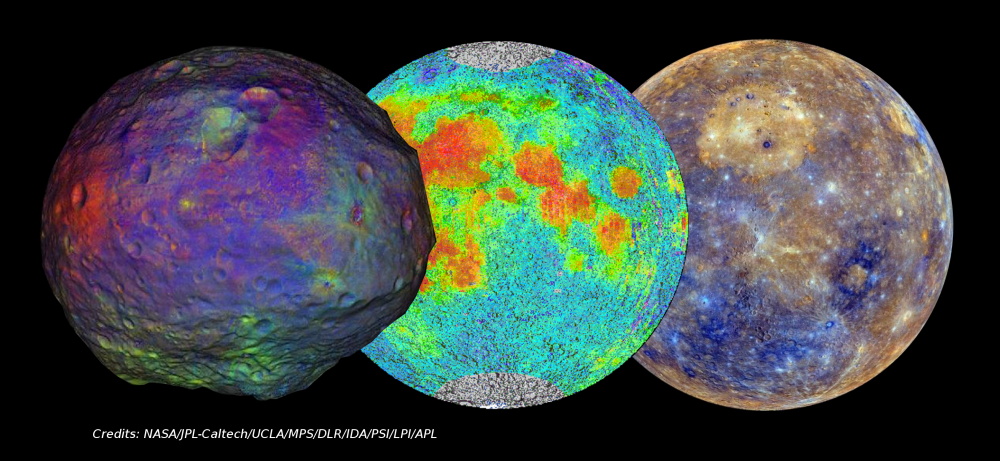About our project
The mineralogy and average composition of the surfaces of airless bodies observed today in our Solar System are the result of formation and evolution processes that occurred over geologic timescales. Remote-sensing of a given surface composition is a function of: i) bulk chemistry and internal evolution, ii) external contributions (i.e.infalling material), and iii) surface processes that include gravity-induced transformations (e.g. mass-wasting) and space weathering (i.e. which results of exposition to the space environment) that may partially or totally alter the original physical and chemical properties of the exposed materials. Untangling these three contributions for several objects is an essential step towards reconstructing the formation conditions and geological history for
each of them individually, compare this information between them, and improve our general understanding of telluric planets, satellites and asteroids of the inner Solar System collectively. Over the last decade or so, there has been a dramatic increase in our knowledge of the mineralogical and geochemical context of airless planetary bodies such as Vesta, Mercury, and the Moon, thanks to visible to near-infrared and nuclear remote sensing instrumentation carried onboard several planetary space missions (e.g., Dawn, MESSENGER, Chandrayaan-1). The subsequently large amount of collected data was crucial for identifying the nature and the distribution of the main chemical and mineralogical species. Resulting high-level products such as global compositional maps reveal that while each of these bodies is unique in its composition and surface evolution, they share similarities that must be interpreted. The next logical step is to analyze the available data from all these missions combined in order to better understand the general context of the formation and evolution of the inner Solar System that resulted in the surface compositions observed today. To combine space observations from multiple instruments, theory, and ground truth from laboratory investigations, we propose to bring together an international team with representatives from different branches of planetary sciences. Technically, in order to identify correlations in the datasets, we will rely on multivariate statistical methods. The expected outcome, unprecedented, will be to quantify the similarities and differences in the surface compositional properties of Vesta, Mercury and the Moon, substantially enhancing the scientific return of individual instrumental datasets and/or individual space missions.
Our project is focused on two specific questions:
- Why do the chemical changes induced by space weathering in surface regoliths appear to be so different on Vesta, Mercury and the Moon and what is the role of primary mineralogy and composition?
- The question of the presence and abundance of olivine at the surface of Vesta is a case in point that requires not only better identification of that mineral, but also its relationship with associated phases. Given that olivine has also been found on the Moon, but not identified on Mercury, what are the implications for all
three of these planetary bodies?
This ‘broad view approach’, using the latest publicly available datasets from space-based missions to further overarching knowledge of the formation and evolution of the rocky bodies of the Solar System, echoes the mission of ISSI-Bern and would be a key factor in the success of our project. To fully address the above questions, we plan to deliver a final report summarizing our activity, to write at least one paper in an international, peer-reviewed scientific journal, and to publicly release high-level products (e.g. maps of spectral parameters and abundances of mineral phases) that could be used in the future by the science community.
